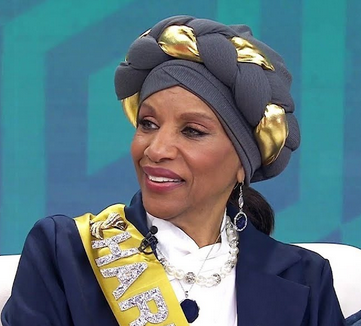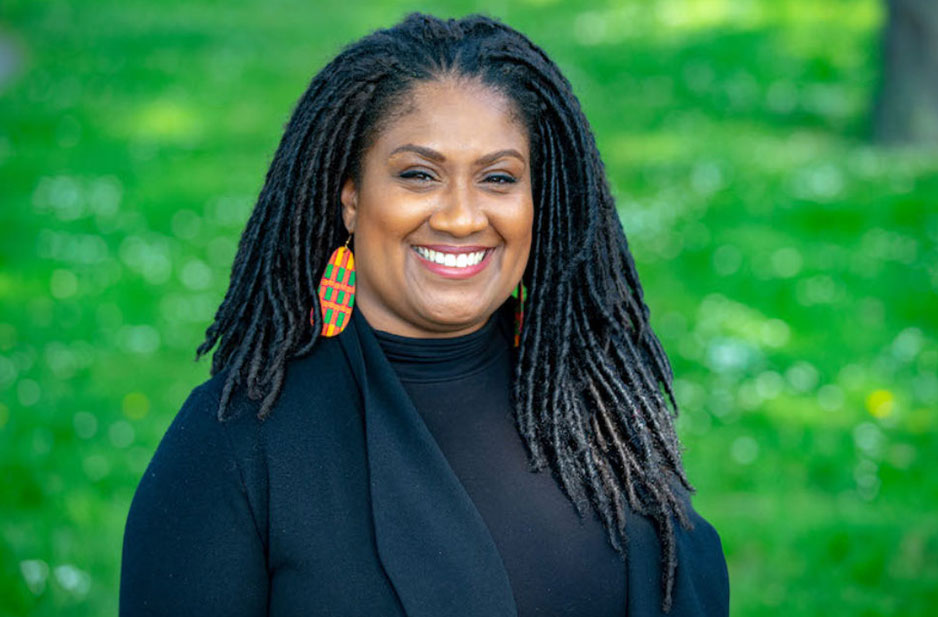In this Black History Month, Rita Daniels, who has a new book out titled “Harriet Tubman: Military Scout and Tenacious Visionary,” shared how surviving family members continue to honour the legendary abolitionist.
Rita (pic) didn't always know she was the great-great-great-grandniece of Harriet Tubman. In fact, at 9-years-old, she had no idea they were related when her teacher assigned her a book report on Tubman.
At the time, Daniels, who lived in Auburn, New York, where Tubman lived for the majority of her life, could only unearth research that said Tubman was a "fugitive" and there "was a bounty of her head," she said.
Unsatisfied, she went to her mom with the assignment, curious about why she'd been asked to research a figure who seemingly did what she was "raised to not do." This moment would change Daniels life forever.
Her mom revealed that they were descendants of Tubman, whom Daniels now affectionately calls "Aunt Harriet," a fact her mom had discovered while comparing family trees in her 20s. "She says, 'But your Aunt Harriet was not the kind of villain that they make her out,'" Daniels recalls of her mother explaining the inaccuracies in the research at that time.
Daniels dived into the book report, using some of her elder aunts and uncles to gather knowledge on Tubman that the school library didn't have. "I got an AAA (grade) on (the book report) because I had more information than the schoolbooks had," she says.
But that assignment was just the beginning of Daniels journey of family discovery and preserving Harriet Tubman's legacy. This month, Daniels released her book called "Harriet Tubman: Military Scout and Tenacious Visionary," which she co-wrote with author Jean Marie Wiesen.
It aims to correct the misconceptions that previous books and research have reported about Tubman. She says there's a long list of errors, like that she would "jump off a cliff," as seen in the 2019 film "Harriet," or that she would be "caught in bushes" and "having sex with other people just to get through."
Daniels wants her book to spread awareness of Tubman's true legacy and actions, properly documenting Tubman's life that "went from one extreme to another." She also hopes the book encourages others to dive into their own ancestral past.
"Other people need to find out what is their journey, who they are they related to, who survived some type of — I can't (necessarily) say slavery — but some type of goodness, or whatever it is," she adds.
"Go and follow that journey, get the book so you could see why Harriet Tubman's story was so important to be told. If she could do it, so can others." Daniels isn't the only one in her family who works to honour Tubman's life.
Read on to learn about some of the late abolitionist’s other surviving family members. Daniels, who comes from a family of nine children, has taken it upon herself to ensure others know what Tubman stood for so people don't forget the past.
“If a slave would make that long journey over to the United States from Africa and not have anything — everything stripped from her, and I look at it as, ‘Wow, that’s strength,’ and you can’t hold us back,” Daniels says.
“We’re not going back. Those are my words. We’re not going back," she adds.
In 2015, Daniels started the Harriet Tubman Learning Centre in Powder Springs, Georgia, alongside her mother, Geraldine Copes-Daniels, with a mission to carry out Tubman's legacy through improving the literacy of underserved children. Daniels says that "slaves were not allowed to learn how to read or write," so Tubman "never had that opportunity to learn."
"Slaves were not supposed to have any type of skill sets when it came to school or anything like that, and if they if someone even tried to teach them, they would either be hung or lynched," she explains. She and her mother started the learning centre because they wanted to support underserved children who otherwise didn't have learning resources available.
"We know they come in there and they can’t read properly, or they can’t do certain things, but we don’t focus right in on the school the problem," Daniels says. "We bring them in, we feed them, and then right after that, we get them, we teach them how to build a robot.”
While the learning centre shut its doors during COVID-19, her family is working on raising the funds to reopen it. Outside of Daniels, there are other family members who have publicly spoken about Tubman's lasting impact.
Pauline Copes Johnson, 97, is the great-great-grandniece of Tubman. She was born and raised in Auburn, New York, where Tubman lived for about 50 years until her death.
Daniels explains that Copes Johnson has done various advocacy work to honour Tubman's legacy throughout much of her life: She taught at the Harriet Tubman Home, and also assisted the U.S. Department of the Interior’s initiative to create the Harriet Tubman National Historic Park. Additionally, Copes Johnson has given presentations on Tubman’s life across the U.S. and even in Ghana.
Copes Johnson also took part in the campaign to get Tubman's face on the $20 bill in place of former President Andrew Jackson, which has yet to take place. Daniels says that stories of Tubman have been passed down throughout the generations and shared at family reunions at Tubman’s former residency in Auburn, New York.
A resident of Washington, D.C., Ernestine “Tina” Martin Wyatt is one of Tubman's great-great-great-grandnieces. "My great-great-grandmother, Ann Marie Stewart, was the daughter of Soph, one of Tubman’s sisters who was sold away,” she said in a May 2021 interview.
“We think it was to Georgia." Wyatt pioneers an annual celebration called Harriet Tubman Day, which aims to educate others on her ancestor's legacy. She has also spoken on Tubman's legacy at various events, such as a virtual conversation about Tubman hosted by the Northwest African American Museum in 2021.
"She is a true American Patriot and chose to help preserve the Union by risking her life and liberty to do it,” Wyatt shared.
“She continued to serve and help people who were marginalized, disenfranchised, and in need. I would say look at her life and what she accomplished with the span of time from her self-liberation in 1849 until 1913, how she rose up out of it and uplifted others."
Like Copes Johnson, she has also spoken about the importance of getting her ancestor on the $20 bill. “That $20 bill, for me, represents something greater about who she was and what she gave to the United States,” Wyatt said in January 2024.
“She is a symbol of true democracy in this country, and we have to pay attention to the symbols that we want to represent it.” Judith G. Bryant is the great-great-grandniece of Tubman and currently resides in Auburn, New York.
Bryant, a descendant of Tubman's brother, William Henry Stewart, Sr., told Ms. Magazine in a January 2022 interview that she views the social activist like any other family member. “Harriet Tubman is like a stage name for me,” she said.
“That’s not who she was to herself or to her family here. In Auburn, she was Mrs. Davis. The public has no clue about who she really was as a person, as a member of our family.”
Bryant has spoken at services, events and ceremonies that involve Tubman's legacy, including the opening ceremony for the Thompson Memorial African Methodist Episcopal Zion Church, which is part of the Harriet Tubman National Historical Park in Auburn, New York. Joan Rebecca Stewart Springfield-Butler — a descendant of Tubman’s brother, James Stewart — lives in Schenectady, New York.
She discovered her connection to Tubman when she was in her 30s. “I didn’t know about being related to her until I was about 36 or 37," she said in a January 2022 magazine feature.
"I was a little upset because she was in the schoolbooks when I was in school, and there weren’t many Black people in there at that time, and I could have said, ‘Well, I’m related to her.’’’
Springfield-Butler said that her father was 13 when Tubman died. “He remembered her sitting at the table and talking and falling asleep,” she said.
“And then she picked up right where she left off when she woke up. We had a room in my grandfather’s house that my uncle was living in, and the room was empty except for a Bible and gun.
“I once asked whose they were, and they said, ‘Oh, a relative.’ I had no idea that they were Harriet Tubman’s! And then my uncle lost them when he moved from that house to another house."
Michele Jones Galvin is a great-great-great grandniece of Tubman. She co-authored a book on Tubman's life called “Beyond the Underground.
Aunt Harriet, Moses of Her People” with her mother, Joyce Stokes Jones, who has since died. When Galvin was in fourth grade, she was assigned a school report to pick "an important individual who was greatly admired" in the course of history, per Syracuse Woman Magazine.
She considered writing about Tubman but ultimately chose another subject as there was not enough information available regarding her ancestor. “Then it hit me,” Galvin told the outlet.
“And then, I learned that I should never have squandered that opportunity to share with my classmates and my teacher about the relationship with Aunt Harriet.” Her mother went on to research Tubman's life heavily, producing a documentary called ‘A Conversation with a Living Relative of Harriet Tubman.’
The mother-daughter duo also published a book on Tubman, which mixes "family lore, memoir and historical reconstruction," according to the official description. Valerie Ardelia Ross Manokey is Tubman’s great-great-niece. She is a mother of five who lives in Maryland, per the National Parks Conservation Association.
In an interview with NPCA published in 2017, Manokey recalled that when she was growing up, her parents would always tell her, "Remember Aunt Harriet. If she could endure, so can you."
Manokey said in the 1950s, her family advocated for a Harriet Tubman memorial, but it never came to fruition. “People told us, ‘You’ll never get anything,’” Manokey told the association.
“But ‘never’ means you have just got to fight harder. You might get knocked back to your knees, but you are going to get back up.”
Starting as a teacher's aide, Manokey taught children about Tubman, far beyond what was being shared at the time. "I didn’t feel like I was a good teacher,” she said.
“I knew I was. I had confidence. I had pride.”
Manokey spoke on Tubman's legacy today, saying, “I honour Harriet, and I honour the name.
“I honour the stories that I have heard. And I thank God that I have lived long enough to see this.”
Charles E.T. Ross is Tubman's great-great-great-nephew and Manokey's nephew. Ross carries out Tubman's mission of helping others through his role as an education specialist, according to the National Parks Conservation Association.
“I need to basically continue what she did," he shared with the outlet.
He continues Tubman’s legacy through art, as seen through the mural he painted of her in Dorchester County, which his aunt said shows a young Tubman and marshy terrain, per the association. Ross also volunteers at the Harriet Tubman Museum and Educational Centre in Cambridge, Maryland.











